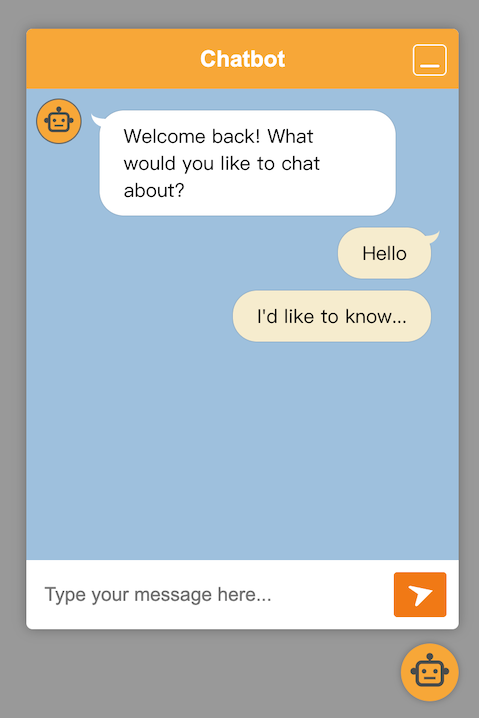package.README.md Maven / Gradle / Ivy
Go to download
Show more of this group Show more artifacts with this name
Show all versions of wc-chatbot Show documentation
Show all versions of wc-chatbot Show documentation
A simple WebComponent for chatting with real people or bots, such as OpenAI ChatGPT or Google Bard AI.
The newest version!
# wc-chatbot
[![published][wc-image]][wc-url]
[![coverage][coverage-image]][coverage-url]
[![npm][npm-version-img]][npm-url]
[![npm][npm-download-img]][npm-url]
[](https://www.jsdelivr.com/package/npm/wc-chatbot)
[![GitHub issues][github-issue-img]][github-issue-url]
![license][license-img]
[](https://www.npmjs.com/package/wc-chatbot)
A user-friendly chatbot UI WebComponent that streamlines the integration of backend services for chatting with both human agents and AI bots. This component allows easy integration with popular AI services such as OpenAI ChatGPT, Google Bard AI, and others, into your website or application.

## Installation
You can install `wc-chatbot` with npm, or just get started quickly with CDN.
### Install from npm
To install from npm, open terminal in your project folder and run:
```shell
npm install wc-chatbot
```
After the package is installed, then you can import the chatbot WebComponent into you code:
```js
import Chatbot from 'wc-chatbot';
window.onload = function() {
let chatBotElement = document.createElement('chat-bot');
document.body.appendChild(chatBotElement);
}
```
### Install from CDN
There is `jsDelivr` CDN available for quickly integrated with your web page.
```html
```
#### Basic Usages:
```html
Welcome back! What would you like to chat about?
",
"continued": false,
"right": false,
"delay": 0,
"loading": false,
"sender": {
"name": "bot",
"id": "00000000-0000-0000-0000-000000000001",
"avatar": "https://ui-avatars.com/api/?name=Bot"
}
},
{
"message": "hello
",
"continued": false,
"right": true,
"delay": 0,
"loading": false,
"sender": {
"name": "Anonymous",
"id": "00000000-0000-0000-0000-000000000002"
}
}
]
*/
}
```
## Method
### sendMessage(str, options)
This method sends a message to the chatbot UI. The `str` parameter is a string containing the message to be sent. The `options` parameter is an optional object of type `Message`, containing additional options for the message.
#### Parameters
- `str` - A string containing the message to be sent.
- `options` - An optional object of type Message containing additional options for the message.
#### Message Options
The `Message` object can contain the following properties:
- `message` - A string containing the message to be sent.
- `continued` - A boolean indicating whether the message should be displayed in a continued message bubble. Default value is false.
- `right` - A boolean indicating whether the message should be displayed on the right side of the chat UI. Default value is false.
- `delay` - A number representing the delay in milliseconds before the message is displayed in the chat UI. Default value is 0.
- `loading` - A boolean indicating whether the message is a loading message. Default value is false.
- `sender` - An object of type Sender containing information about the message sender. The sender object can contain the following properties:
- `name` - A string containing the name of the message sender.
- `id` - A string containing the ID of the message sender.
- `avatar` - An optional string containing the URL of the message sender's avatar.
Examples:
```js
const chatBot = document.querySelector('chat-bot');
// Send Bot message
chatbot.sendMessage('Hello, how can I help you?', {
right: false,
sender: {
name: 'bot',
id: '001',
avatar: 'https://ui-avatars.com/api/?name=Bot'
}
});
// Send User message
chatbot.sendMessage('Hi', {
right: true,
sender: { name: 'Alice', id: '007' }
});
// Send HTML message
chatbot.sendMessage(null, {
message: 'Link: Github
',
right: false,
sender: {
name: 'bot',
id: '001',
avatar: 'https://ui-avatars.com/api/?name=Bot'
}
});
```
> Warning:
It is better to send a HTML message only with the trusted data source, or doing HTML sanitization before sending.
### hideLoading(index)
This method is used to remove a specific `loading` bubble from the chatbot UI.
#### Parameters
- `index` - The index of the chat-bubble element to be removed.
### hideAllLoading()
This method is used to remove all `loading` bubbles from the chatbot UI.
### hideLastLoading()
This method is used to remove the last `loading` bubble from the chatbot UI.
## Event
### sent event
When a message is sent by calling, a `sent` event will be dispatched and with the `message` in the detail.
For example:
```js
const chatBot = document.querySelector('chat-bot');
chatBot.addEventListener("sent", function(e) {
console.log(
"A message is sent:",
e.detail.message
);
});
```
## Customized styles
By specifying CSS variables, you can customize the chat chatbot styles aboiut the color and avatar.
For example:
```html
```
| CSS Variable Name | Description |
| ------------------ | ------------ |
| --chatbot-avatar-bg-color | This variable sets the background color of the avatar used for the chatbot. |
| --chatbot-avatar-img | This variable sets the image used for the avatar. It's a url path of the image in this case,
and you can also specify a base64 encoded image as the value. |
| --chatbot-avatar-margin | This variable sets the margin for the avatar. |
| --chatbot-header-bg-color | This variable sets the background color of the chatbot header. |
| --chatbot-header-title-color | This variable sets the color of the title in the chatbot header. |
| --chatbot-body-bg-color | This variable sets the background color of the chatbot message box. |
| --chatbot-send-button-color | This variable sets the color of the send button. |
### Bubble element style
And you can also customize the `chat-bubble`, too. For example:
```html
```
To see the styles can be customized, please look the document of [wc-bubble](https://github.com/yishiashia/wc-bubble).
[wc-image]: https://img.shields.io/badge/webcomponents.org-published-blue.svg?style=flat-square
[wc-url]: https://www.webcomponents.org/element/wc-chatbot
[npm-version-img]: https://img.shields.io/npm/v/wc-chatbot.svg?style=flat-square
[npm-download-img]: https://img.shields.io/npm/dm/wc-chatbot.svg?style=flat-square
[npm-url]: https://www.npmjs.com/package/wc-chatbot
[coverage-image]: https://img.shields.io/endpoint?style=flat-square&url=https%3A%2F%2Fgist.githubusercontent.com%2Fyishiashia%2Fdee60aefdce58a7559baeb7c5deb3a8b%2Fraw%2F177b2224ae86a8c54556813eb1521e987b00aad7%2Fwc-chatbot__heads_main.json
[coverage-url]: https://gist.github.com/yishiashia/dee60aefdce58a7559baeb7c5deb3a8b#file-wc-chatbot__heads_main-json
[github-issue-img]: https://img.shields.io/github/issues/yishiashia/wc-chatbot.svg?style=flat-square
[github-issue-url]: https://github.com/yishiashia/wc-chatbot/issues
[license-img]: https://img.shields.io/npm/l/wc-chatbot.svg?style=flat-square
